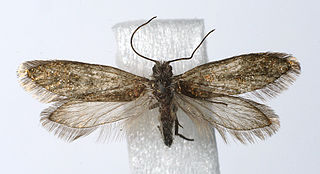Related Research Articles
Scrobipalpula is a genus of moths in the family Gelechiidae.

Eriocrania cicatricella is a moth of the family Eriocraniidae. It is found in Europe.

Eriocrania chrysolepidella is a moth of the family Eriocraniidae. It is found in Europe, from Finland to the Pyrenees and Italy, and from Ireland to Romania.
Ectoedemia occultella, the small birch leafminer, is a moth of the family Nepticulidae. It has a Holarctic distribution. It is found in most of Europe, east through Russia to Japan. It is also present in North America. Mines very similar to that of Ectoedemia occultella have been found on Rosaceae species in Nepal and Japan and these may belong to this species.
Leucoptera lotella is a moth in the Lyonetiidae family. It is found from Denmark to Portugal, Italy and Croatia, and from Great Britain to Poland and Hungary.
Phyllonorycter deschkai is a moth of the family Gracillariidae. It is known from Alps on altitudes between 500 and 1,750 meters.
Stomphastis rorkei is a moth of the family Gracillariidae. It is known from South Africa, Namibia and Zimbabwe.
Phyllocnistis liquidambarisella is a moth of the family Gracillariidae, known from the United States. The hostplant for the species is Liquidambar styraciflua. They mine the leaves of their host plant. The mine has the form of a long, winding, linear mine on the upperside of the leaf. It is rather indistinct, without any central line of frass.
Caloptilia invariabilis is a moth of the family Gracillariidae. It is known from Canada and the United States.
Coleophora boreella is a moth of the family Coleophoridae. It is found from Fennoscandia and northern Russia to the Netherlands and Poland.

Scrobipalpula diffluella, the Essex groundling, is a moth of the family Gelechiidae. It is found in northern Europe, and central Europe. There are scattered records from Great Britain and the Balkan Peninsula.
Scrobipalpula artemisiella, the thyme moth, is a moth in the family Gelechiidae. It was described by William D. Kearfott in 1903. It is found in the United States, where it has been recorded from California, Arizona, Illinois, Maine, Maryland and Ohio.
Scrobipalpula densata is a moth in the family Gelechiidae. It was described by Edward Meyrick in 1917. It is found in Argentina, Peru and on the Galápagos Islands.
Scrobipalpula seniorum is a moth in the family Gelechiidae. It was described by Povolný in 2000. It is found in North Macedonia and Greece.
Scrobipalpula semirosea is a moth in the family Gelechiidae. It is found solely in North America, where it has been observed in Texas.
Scrobipalpula manierreorum is a moth in the family Gelechiidae. It was described by Ronald J. Priest in 2014. It is found in North America, where it has been recorded from Alberta, British Columbia, Manitoba, Michigan, Ontario and Quebec.
Scrobipalpula potentella is a moth in the family Gelechiidae. It was described by Keifer in 1936. It is found in the United States, where it has been recorded from California, Mississippi and Tennessee.
Scrobipalpula ramosella is a moth in the family Gelechiidae. It was described by Muller-Rutz in 1934. It is found in the Alps of France and Switzerland.
Scrobipalpula tussilaginis is a moth in the family Gelechiidae. The original publication for the name appears to be by Stainton in 1867, but it is sometimes attributed to Frey. It is found in Great Britain, Sweden, the Netherlands, France, Germany, Denmark, Austria, Switzerland, Italy, Poland, the Czech Republic, Slovakia, Slovenia, Hungary, Romania, the North Macedonia, Greece, Ukraine and Russia.
Nealyda pisoniae is a moth of the family Gelechiidae. It was described by August Busck in 1900. It is found in Cuba and the United States, where it has been recorded from Florida.
References
- ↑ Savela, Markku. "Scrobipalpula Povolný, 1964". Lepidoptera and Some Other Life Forms. Retrieved October 30, 2017.
- ↑ Moth Photographers Group at Mississippi State University
- ↑ The Canadian Entomologist 4 (9): 173
| This article on a moth of the genus Scrobipalpula is a stub. You can help Wikipedia by expanding it. |